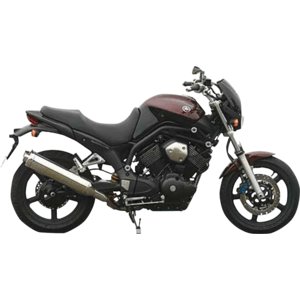Yamaha BT 1100 Bulldog [2005-2006]: The Unconventional Urban Companion
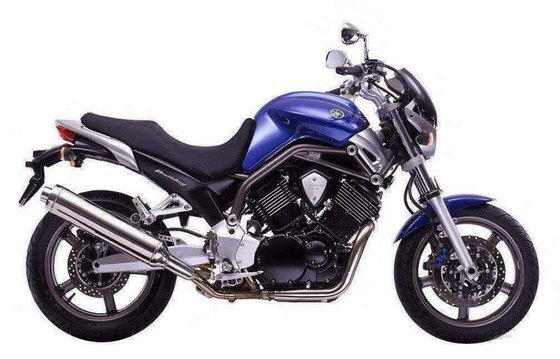
Introduction
The Yamaha BT 1100 Bulldog is a motorcycle that defies easy categorization. Produced between 2005 and 2006, this V-twin-powered machine blends elements of muscle bikes, retro styling, and urban practicality into a package that remains intriguing even by modern standards. With its bold aluminum frame, aggressive stance, and torquey engine, the Bulldog carves out a niche as a rebellious yet approachable ride. But does it live up to its tough-guy name? Let’s saddle up and find out.
Design & Styling: Brutish Charm
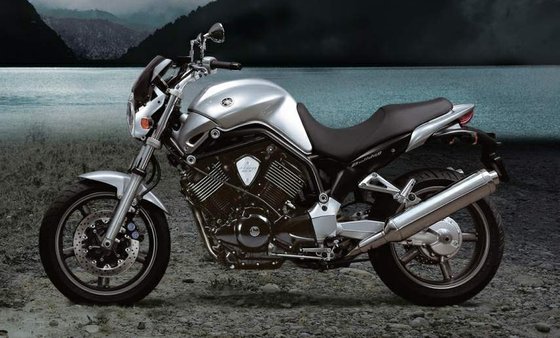
The Bulldog’s design is its first conversation starter. Yamaha’s collaboration with GK Design (an external studio) resulted in a bike that’s equal parts brawn and artistry. The aluminum single-cradle frame plunges dramatically over the 1,063cc V-twin engine, creating a visual focal point that screams mechanical honesty. The hunched fuel tank, minimalist flyscreen, and chunky 170-section rear tire give it a squat, muscular profile reminiscent of a pitbull ready to pounce.
Detailing is where the Bulldog shines. From the sculpted side covers to the polished aluminum accents, Yamaha avoided cheap plastics in favor of materials that age gracefully. The twin staggered exhaust pipes add a touch of asymmetry, while the R1-derived front brakes hint at hidden performance potential. It’s a bike that looks equally at home parked outside a Milanese café or a gritty urban garage.
Engine & Performance: Gentle Giant
The Heart of the Matter
At its core lies a 75-degree air-cooled V-twin borrowed from the XVS1100 Drag Star cruiser. With 64.1 HP (47.4 kW) at 5,500 RPM and a meaty 88.3 Nm (65.1 ft.lbs) of torque peaking at 4,500 RPM, this isn’t a motor built for outright speed. Instead, it’s all about accessible grunt.
Throttle Response: Twist the grip, and the Bulldog lurches forward with a satisfying growl. The fuel-injected engine (post-2003 models) delivers linear power, free of the abruptness that plagues some modern twins. It’s happiest between 3,000–6,000 RPM, where torque flows like a lazy river—perfect for city commutes or relaxed highway cruising.
Top Speed & Fuel Efficiency: Yamaha claims a top speed of 177 km/h (110 mph), though hitting that requires patience and a willingness to tuck behind the tiny flyscreen. More impressive is the fuel economy—6.06 L/100 km (38.8 mpg)—a figure that puts many smaller bikes to shame.
Shaft Drive: The cardan final drive eliminates chain maintenance and adds to the Bulldog’s "hop-on-and-go" appeal. While it introduces a slight driveline lash during aggressive acceleration, most riders will appreciate the trade-off for hassle-free ownership.
Handling & Ride: Surprising Agility
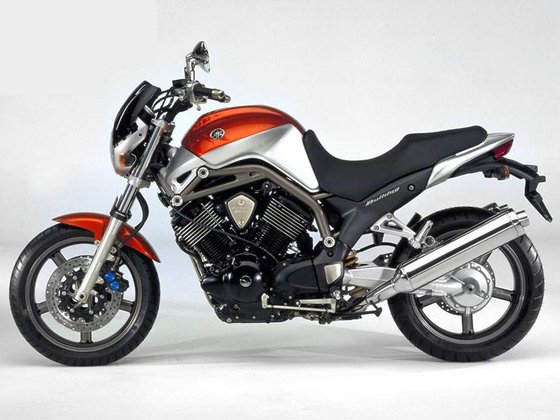
Chassis Dynamics
The Bulldog’s aluminum frame and 43mm telescopic forks promise sporty handling, but this is no canyon carver. With a wet weight of 251 kg (553 lbs) and a wheelbase of 1,530 mm (60.2 inches), it leans more toward stability than flickability. That said, the wide handlebars offer ample leverage for tight urban maneuvers.
Suspension Setup:
- Front: Non-adjustable 43mm forks with 130 mm (5.1 inches) of travel. Plush over cobblestones but soft under hard braking.
- Rear: A rising-rate monoshock with 125 mm (4.9 inches) of travel. Handles bumps competently but struggles with spirited cornering.
Brakes: The R1-sourced dual 298mm front discs and four-piston calipers are overkill—and that’s a good thing. Stops are confident and progressive, though the rear brake (a single 282mm disc) locks up easily under heavy use.
Tires: The 120/70-ZR17 front and 170/60-ZR17 rear Metzeler MEZOs provide grip that far exceeds the engine’s modest output. Rain or shine, they inspire confidence.
Comfort & Ergonomics: Urban Throne
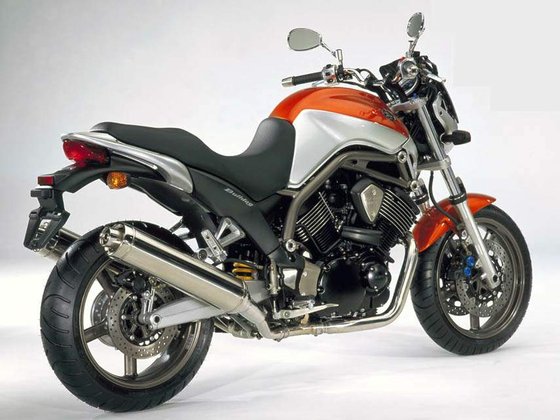
The Bulldog’s riding position is a masterclass in ergonomic neutrality. The 812 mm (32-inch) seat height accommodates shorter riders, while the upright bars and mid-set pegs create a relaxed, commanding posture. Long highway stints reveal two flaws:
1. Wind Protection: The flyscreen is purely decorative. Above 110 km/h (68 mph), you’ll feel like a human parachute.
2. Seat Comfort: The overly sculpted saddle becomes a literal pain after an hour. An aftermarket seat from MOTOPARTS.store is a worthy upgrade.
Vibration is minimal for a V-twin, thanks to rubber-mounted footpegs and a balanced crank. It’s a bike that forgives poor posture and rewards leisurely rides.
Competition: How Does It Stack Up?
The Bulldog’s closest rivals blend retro appeal with everyday usability:
1. Ducati Monster S4 (2001-2005)
- Pros: Lighter, sharper, and packing a 916cc Desmo V-twin with 95 HP.
- Cons: Higher maintenance costs, chain drive, and a cramped riding position.
- Verdict: The Monster is a scalpel; the Bulldog is a Swiss Army knife.
2. Triumph Bonneville T100 (2001-2016)
- Pros: Timeless style, smoother parallel-twin engine, and a cult following.
- Cons: Lower torque (68 Nm) and heavier feel.
- Verdict: The Bonneville charms with nostalgia; the Bulldog wins on practicality.
3. Harley-Davidson Sportster 883 (2004-2006)
- Pros: Iconic brand, customizable, and a visceral exhaust note.
- Cons: Archaic suspension, mediocre brakes, and higher vibration.
- Verdict: The Sportster is a lifestyle choice; the Bulldog is a daily rider.
Bulldog’s Edge: Shaft drive, low-maintenance engine, and R1 brakes make it the rational pick for riders who value substance over status.
Maintenance: Keeping the Bulldog Healthy
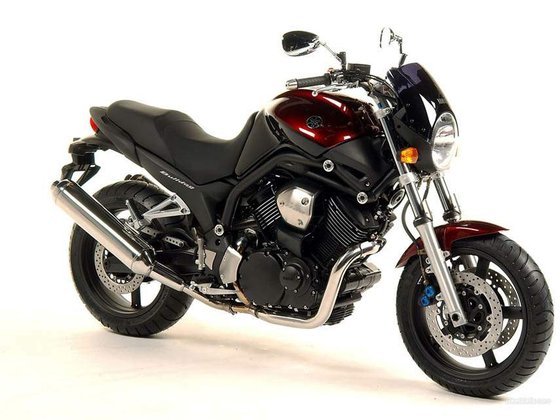
Yamaha’s air-cooled V-twin is notoriously bulletproof, but here’s how to keep it in peak condition:
Key Service Points
- Oil Changes: Use SAE 20W-40 mineral oil every 5,000 km (3,100 miles). The wet sump holds 3.1 liters (3.3 quarts) with a filter.
- Valve Adjustments: Check every 10,000 km (6,200 miles). Intake valves: 0.07–0.12 mm (0.0028–0.0047 in); exhaust: 0.12–0.17 mm (0.0047–0.0067 in).
- Spark Plugs: NGK BPR7ES (standard) or BPR7EIX (iridium). Gap: 0.6 mm (0.024 in).
- Tire Pressures: 33 PSI (2.3 Bar) front / 36 PSI (2.5 Bar) rear.
Common Upgrades
- Exhaust: Swap the stock cans for a free-flowing system to unlock the V-twin’s full acoustic potential.
- Suspension: Progressive fork springs and a preload-adjustable shock transform handling.
- Seat: MOTOPARTS.store offers gel-padded alternatives for marathon rides.
Troubleshooting Tips
- Shaft Drive Lash: Normal at low RPM. Avoid abrupt throttle inputs.
- Soft Front Suspension: Upgrade to 10W fork oil for better damping.
Conclusion: The Underdog Worth Celebrating
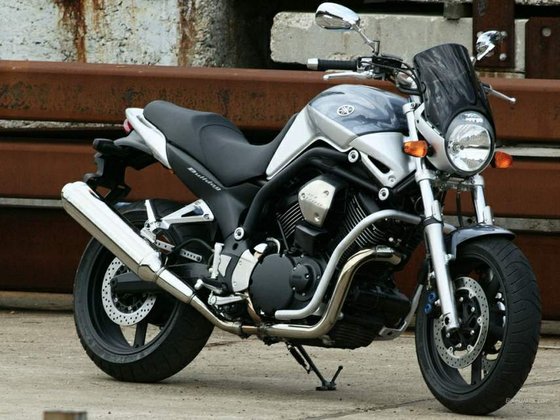
The Yamaha BT 1100 Bulldog isn’t the fastest, lightest, or most technologically advanced bike of its era. What it lacks in pedigree, it makes up for in character and versatility. This is a motorcycle that thrives in the urban jungle, where its torquey engine, low-maintenance drivetrain, and head-turning design earn it a cult following.
For riders seeking a stress-free daily companion with a rebellious streak, the Bulldog delivers. And with MOTOPARTS.store’s catalog of upgrades, it’s easy to transform this quirky V-twin into a machine that’s truly your own.
Ride hard, ride smart, and let the Bulldog’s growl open up the city.

Specifications sheet
| Engine | |
|---|---|
| Stroke: | Four-stroke |
| Max power: | 48 kW | 64.0 hp |
| Max torque: | 88 Nm |
| Fuel system: | Fuel Injection |
| Max power @: | 5500 rpm |
| Displacement: | 1063 ccm |
| Fuel control: | Single Overhead Cams (SOHC) |
| Max torque @: | 4500 rpm |
| Bore x stroke: | 95.0 x 75.0 mm (3.7 x 3.0 in) |
| Configuration: | V |
| Cooling system: | Air |
| Compression ratio: | 8.3:1 |
| Number of cylinders: | 2 |
| Valves per cylinder: | 2 |
| Dimensions | |
|---|---|
| Wheelbase: | 1530 mm (60.2 in) |
| Dry weight: | 233 |
| Wet weight: | 251 |
| Seat height: | 812 mm (32.0 in) |
| Overall width: | 800 mm (31.5 in) |
| Overall height: | 1140 mm (44.9 in) |
| Overall length: | 2200 mm (86.6 in) |
| Ground clearance: | 168 mm (6.6 in) |
| Fuel tank capacity: | 20.0 L (5.3 US gal) |
| Drivetrain | |
|---|---|
| Clutch: | Wet, multiple-disc, cable-operated |
| Final drive: | shaft |
| Transmission: | 5-speed |
| Maintenance | |
|---|---|
| Engine oil: | SAE 20W-40 |
| Brake fluid: | DOT 4 |
| Spark plugs: | NGK BPR7ES or NGK BPR7EIX |
| Spark plug gap: | 0.6 |
| Final drive oil: | 200 ml SAE 80 GL-4 |
| Forks oil capacity: | 1.1 |
| Engine oil capacity: | 3.1 |
| Engine oil change interval: | Every 5000 km or 2 years, whichever comes first |
| Valve clearance (intake, cold): | 0.07–0.12 mm |
| Valve clearance check interval: | 24,000 km / 15,000 mi |
| Valve clearance (exhaust, cold): | 0.12–0.17 mm |
| Recommended tire pressure (rear): | 2.5 bar (36 psi) solo, 2.7 bar (39 psi) with passenger |
| Recommended tire pressure (front): | 2.3 bar (33 psi) |
| Chassis and Suspension | |
|---|---|
| Frame: | Aluminium single cradle |
| Trail: | 106 mm (4.2 in) |
| Rear tire: | 170/60-z-17 |
| Front tire: | 120/70-z-17 |
| Rear brakes: | Single 282 mm disc, 1-piston caliper |
| Front brakes: | 2 x 298 mm discs, 4-piston calipers |
| Rear suspension: | Rising rate monoshock, preload adjustable |
| Front suspension: | 43mm telescopic fork, preload adjustable |
| Rear wheel travel: | 125 mm (4.9 in) |
| Front wheel travel: | 130 mm (5.1 in) |



